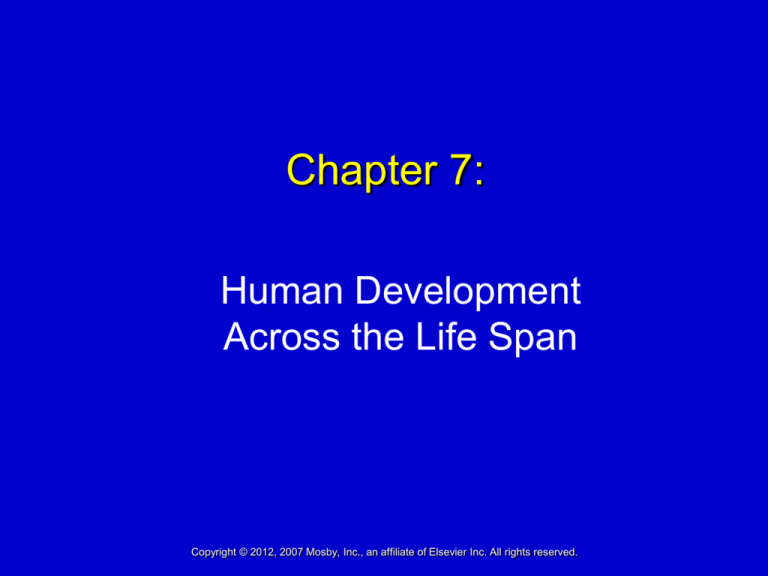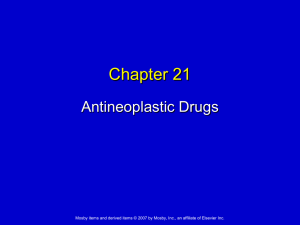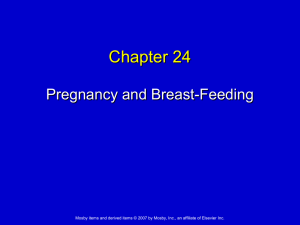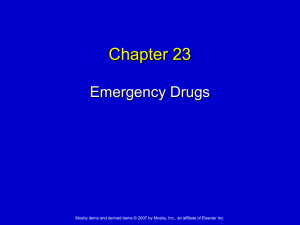
Chapter 7:
Human Development
Across the Life Span
Copyright © 2012, 2007 Mosby, Inc., an affiliate of Elsevier Inc. All rights reserved.
Developmental Theories
How individuals adapt and respond
Heredity, environment, and human
development
Life experiences shape an individual’s
development
Nature versus nurture
Copyright © 2012, 2007 Mosby, Inc., an affiliate of Elsevier Inc. All rights reserved.
2
Freud
Psychosexual Theory
Oral (0-1 year)
Id
Unable to delay gratification
Conflict: feeding
Copyright © 2012, 2007 Mosby, Inc., an affiliate of Elsevier Inc. All rights reserved.
3
Freud
Psychosexual Theory, cont’d.
Anal (2-3 years)
Able to delay gratification
Conflict: bowel training
Copyright © 2012, 2007 Mosby, Inc., an affiliate of Elsevier Inc. All rights reserved.
4
Freud
Psychosexual Theory, cont’d.
Phallic (3-5 years)
Superego
Learns rules, values, guilt, self-esteem
Conflict: Oedipal, Electra
Copyright © 2012, 2007 Mosby, Inc., an affiliate of Elsevier Inc. All rights reserved.
5
Freud
Psychosexual Theory, cont’d.
Latency (6-12 years)
Sexually repressed
Learning mastery
Copyright © 2012, 2007 Mosby, Inc., an affiliate of Elsevier Inc. All rights reserved.
6
Freud
Psychosexual Theory, cont’d.
Genital (13 years and on)
Mature sexuality
Develops ability to love and work
Copyright © 2012, 2007 Mosby, Inc., an affiliate of Elsevier Inc. All rights reserved.
7
Erikson
Psychosocial Theory
Trust vs. mistrust (0-1 year)
Sense of hope
Autonomy vs. shame/doubt (1-3 years)
Sense of willpower
Copyright © 2012, 2007 Mosby, Inc., an affiliate of Elsevier Inc. All rights reserved.
8
Erikson
Psychosocial Theory, cont’d.
Initiative vs. guilt (3-6 years)
Sense of purpose
Competency vs. inferiority (7-11 years)
Gain knowledge
Copyright © 2012, 2007 Mosby, Inc., an affiliate of Elsevier Inc. All rights reserved.
9
Erikson
Psychosocial Theory, cont’d.
Identity vs. role confusion (12-18 years)
Sense of fidelity
Intimacy vs. isolation (young adulthood)
Sense of identity
Copyright © 2012, 2007 Mosby, Inc., an affiliate of Elsevier Inc. All rights reserved.
10
Erikson
Psychosocial Theory, cont’d.
Generativity vs. stagnation (middle adulthood)
Guiding next generation creativity
Ego integrity vs. despair (late life)
Acceptance of life lived
Copyright © 2012, 2007 Mosby, Inc., an affiliate of Elsevier Inc. All rights reserved.
11
Sullivan
Interpersonal Theory
Infancy era (0-2 years)
Self-differentiation
Self system
Good me
Bad me
Not me
Parataxic mode
Copyright © 2012, 2007 Mosby, Inc., an affiliate of Elsevier Inc. All rights reserved.
12
Sullivan
Interpersonal Theory, cont’d.
Childhood era (2-6 years)
Language development
Sublimation
Juvenile era (6-10 years)
Peer interactions
Syntaxic communication
Copyright © 2012, 2007 Mosby, Inc., an affiliate of Elsevier Inc. All rights reserved.
13
Sullivan
Interpersonal Theory, cont’d.
Preadolescent era (10-13 years)
Same-sex chums
Adolescent era (13-17 years)
Lust
Interested in sexual activity
Late adolescent era (17-19 years)
Personal integration
Copyright © 2012, 2007 Mosby, Inc., an affiliate of Elsevier Inc. All rights reserved.
14
Piaget
Cognitive Theory
Sensorimotor period (0-2 years)
Differentiates self
Preoperational period (2-7 years)
Here-and-now thinking
Copyright © 2012, 2007 Mosby, Inc., an affiliate of Elsevier Inc. All rights reserved.
15
Piaget
Cognitive Theory, cont’d.
Cognitive operational period (7-11 years)
Past and present thinking
Formal operational period (11-16 years)
Future thinking
Abstract thinking
Copyright © 2012, 2007 Mosby, Inc., an affiliate of Elsevier Inc. All rights reserved.
16
Behavioral Theories
Classical conditioning
Operant conditioning
Social learning theory
Copyright © 2012, 2007 Mosby, Inc., an affiliate of Elsevier Inc. All rights reserved.
17
Rotter’s Social Learning Theory
Empiric Law of Effect
Behavior potential
Expectancy
Reinforcement value
Psychologic situation
Copyright © 2012, 2007 Mosby, Inc., an affiliate of Elsevier Inc. All rights reserved.
18
Bandura
Paying attention to the modeled behavior
Retention or storing images of the behavior
Reproduction of the behavior
Motivation through reinforcement of the
reproduced behavior
Copyright © 2012, 2007 Mosby, Inc., an affiliate of Elsevier Inc. All rights reserved.
19
Moral Development
Kohlberg
Gilligan
Copyright © 2012, 2007 Mosby, Inc., an affiliate of Elsevier Inc. All rights reserved.
20
Maslow’s Hierarchy of Needs
Selfactualization
Self-esteem
Affiliation/belonging
Safety and security
Biologic and physiologic
Copyright © 2012, 2007 Mosby, Inc., an affiliate of Elsevier Inc. All rights reserved.
21
Needs of Older Adults
Self-Actualization
Meaning in life and death
Transcendence over aging
Creativity and mastery
Copyright © 2012, 2007 Mosby, Inc., an affiliate of Elsevier Inc. All rights reserved.
22
Needs of Older Adults, cont’d.
Self-Esteem
Responsible roles
Social supports
Locus of control
Cognitive awareness
Copyright © 2012, 2007 Mosby, Inc., an affiliate of Elsevier Inc. All rights reserved.
23
Needs of Older Adults, cont’d.
Belonging
Relationships
Intimacy
Affiliations
Copyright © 2012, 2007 Mosby, Inc., an affiliate of Elsevier Inc. All rights reserved.
24
Needs of Older Adults, cont’d.
Safety and Security
Sensory awareness
Environmental safety
Legal/economic issues
Copyright © 2012, 2007 Mosby, Inc., an affiliate of Elsevier Inc. All rights reserved.
25
Needs of Older Adults, cont’d.
Biologic Integrity
Biologic needs
Comfort needs
Copyright © 2012, 2007 Mosby, Inc., an affiliate of Elsevier Inc. All rights reserved.
26
Levinson
Universal Life Cycle
Pre-adulthood (0-17 years)
Early adult transition (17-22 years)
Early adulthood (17-45 years)
Midlife transition (40-45 years)
Middle adulthood (40-65 years)
Late adult transition (60-65 years)
Copyright © 2012, 2007 Mosby, Inc., an affiliate of Elsevier Inc. All rights reserved.
27
Vaillant
Factors Promoting Longevity
Warm, caring marriage
Effective coping strategies
Non-alcohol abusing
Adequate exercise
Recommended weight
Copyright © 2012, 2007 Mosby, Inc., an affiliate of Elsevier Inc. All rights reserved.
28
Vaillant’s Hierarchy of
Adaptive Mechanisms
Level I: Psychotic mechanisms
Level II: Immature mechanisms
Common in severe depression, personality
disorders, and adolescence
Level III: Neurotic mechanisms
Common in psychosis, dreams, childhood
Common in everyone
Level IV: Mature mechanisms
Common in “healthy” adults
Copyright © 2012, 2007 Mosby, Inc., an affiliate of Elsevier Inc. All rights reserved.
29
Biologic Theories of Aging
Genetic
Immunologic
Cross-linkage
Free radical
Copyright © 2012, 2007 Mosby, Inc., an affiliate of Elsevier Inc. All rights reserved.
30
Sociologic Theories of Aging
Disengagement
Continuity
Activity
Copyright © 2012, 2007 Mosby, Inc., an affiliate of Elsevier Inc. All rights reserved.
31
Process of Aging
Physiologic
Psychosocial
Cognitive and memory
Personality
Social support/interactions
Sexuality/intimacy
Role transitions
Copyright © 2012, 2007 Mosby, Inc., an affiliate of Elsevier Inc. All rights reserved.
32





